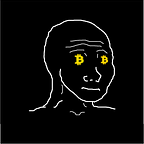Navigating price action in illiquid markets
How do you make sense of the price action in an illiquid market? Funny looking charts are hard to analyse, levels aren’t clear at all and cycles are short.
In this article, I will provide you with a theory that I use to navigate through all the chaos. Introducing: Wyckoff.
Wyckoff price cycle
According to Wyckoff, the market can be understood and anticipated through a detailed analysis of supply and demand.
Demand > Supply = Markup in price.
Supply > Demand = Markdown in price.
Supply = Demand = Range.
Sounds easy? It is. But to make sense of it all, we need to take a further look into the market stages.
Wyckoff market stages
Accumulation = Macro downtrend break.
Distribution = Macro uptrend break.
Reaccumulation = Micro uptrend break after macro range breakout.
Redistribution = Micro downtrend break after macro range breakdown.
Accumulation: An accumulation range is characterised by a macro downtrend being broken, a selling climax, fud and a breakout.
A macro downtrend is broken and a range is formed. A selling climax occurs when the fud is at it’s highest, whales are buying the dump, accumulating tokens at wholesale prices by shaking out weak hands. When price breaks above the range, the accumulation range has been confirmed.
My suggestion is that you try to find some inside knowledge such as unreleased news, and check if a macro downtrend has been broken. If so: You can start accumulating a small bag. As soon as the range has been confirmed by a breakout, it’s safe to buy more.
Reaccumulation: A reaccumulation range is essentially a range in an uptrend. Weak hands are being shaken out by temporary bearish price action. Whales reaccumulate in these ranges before it breaks out again.
The reaccumulation range is characterised by a micro uptrend break after a breakout of an accumulation range. It is important to distinguish a macro uptrend from a micro uptrend. Because when a macro uptrend is being broken; chances are that the range that is being formed isn’t reaccumulation but distribution.
Distribution: The macro uptrend breaks, everyone is still euphoric and bullish. It’s hard to wrap your head around the fact that a macro diagonal has been broken. You don’t believe the bears and price bounces off support to the range high. You think it will break out again but after a period of ranging, it breaks down.
Sounds familiar? Allow me to introduce you to the distribution range. This range is characterised by a macro uptrend break and euphoria. Remember when bitcoin hit 20k and mainstream media was all over it? A prime example of a distribution range.
Redistribution: Inverse reaccumulation. micro downtrend break, macro downtrend intact.
Now you know the basics of Wyckoff’s theory on market events, you can start navigating through current price action without support, resistance and indicators.
I highly suggest that you combine this with your current technique and learn more about this subject.
Disclaimer: Do not use Wyckoff to confirm your bias as you can easily misinterpret a trend’s scale.
